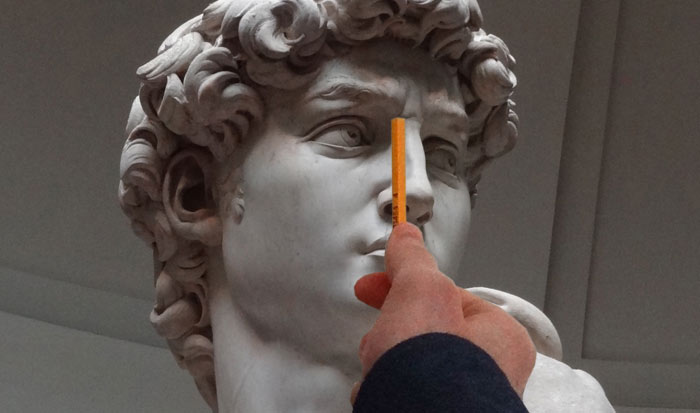Question from Clayton, Drawing Academy student
What is the best way to measure with a pencil?
Can you explain in more detail how I can measure the proportions of what I am drawing with my pencil?
Many thanks,
Clayton
Hi Clayton,
Many thanks for your questions.
Measuring with a pencil serves four purposes:
1. Measuring proportions on a model;
2. Checking proportions in a drawing;
3. Measuring angles on a model and checking them in your drawing;
4. Checking the cross-sections and points where one line crosses another, both on a model and in your drawing.
Measuring proportions is the process of analyzing how many times one part of an object fits into another part.
Measuring angles involves checking the tilts of certain lines.
Checking cross-sections and cross-points entails finding and checking where certain lines intersect other lines.
I’ll explain how to do all these things below.
First of all, it is recommended that you develop your ability to measure proportions and angles by eye. You have to rely on your drawing skills, not on measuring tools.
When you apply constructive drawing principles, you can draw objects, judging the proportions and angles by eye and then double-check by measuring with a pencil.
1. Measuring proportions on a model.
- Extend your arm fully while holding your pencil with the ‘candle’ grip. The pencil can be positioned vertically, horizontally or tilted left or right, but not forward or backward.
- With one eye closed, align the pencil with the model/object. Move your thumb along the pencil so that what you’re measuring fits between the edge of the pencil and the tip of your thumb.
- Now, keeping your thumb still, align the pencil with another, larger portion on the model and see how many times the first size fits into the new one.

In this way, you may check, for example, how many times the head of the model fits into the body, or how many times the nose fits into the height of the face, and so on.

2. Checking proportions in a drawing
When you know what a given proportion is, you can double-check it in your drawing.
- Take your pencil and align it with the given dimension in the drawing.
- Using your index finger, mark this dimension on the pencil.
- Keeping your finger still, re-align the pencil with the larger dimension you checked on the model.
- Check how many times the smaller dimension in your drawing fits into the larger one.
Needless to say, the ratio between these two dimensions has to be the same in your drawing and on the model. If not, fix the drawing.

3. Measuring angles on a model and checking them in your drawing
Here, we are interested in angles and tilts rather than dimensions and proportions.
- Position your drawing board vertically at the arm’s length, so you can see the model and the drawing at the same time.
- Fully extend your arm while holding your pencil with a ‘candle’ grip.
- With one eye closed, align the pencil with the angle you want to measure on the model/object. Do not tilt the pencil forward or backward, it has to be perpendicular to your line of sight.
- Without changing the tilt of the pencil, move your straight arm towards the drawing and check whether the tilt aligns with the given angle in your artwork. If not, fix the angle in your drawing.


4. Checking cross-sections and points where one line crosses another, both on a model and in your drawing
This measurement is similar to the previous exercise. However, instead of checking only angles, this time you need to analyze at what point a line will intersect other line.
- Use the same vertical position of a drawing board as in the previous process.
- Extend your arm as you did to measure angles on the model.
- Align the pencil with the line in question on the model and check where this line crosses other lines.
- Check these cross-sections and cross-points in your drawing, fixing it if required.
A good example of this method is when drawing a still-life – you can extend with a pencil the line of one object and check where it will intersect another object(s).

I hope this helps.
To your creative success,
Vladimir






This is really awesome. It’s great to find excellent tried and true drawing techniques.